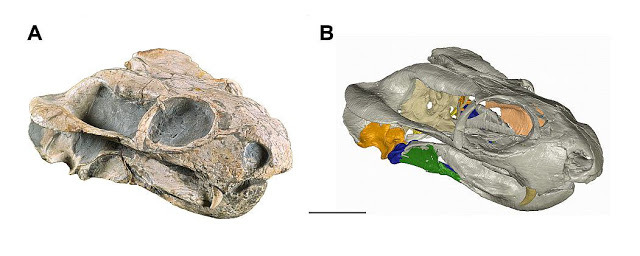
A recent study by means of neutron tomography revealed that some forerunners of mammals were already able to hear airborne sound, because these animals already possessed an eardrum at the lower jaw, an impedance-matching middle ear and a small cochlea.
Most land animals can only hear sound from the air via a specialised area for sound reception – the eardrum. Furthermore, the middle ear consisting of three ear ossicles, the malleus, incus and stapes, amplifies sound impulses from the eardrum, and the cochlea is responsible for transforming a wide range of sound frequencies into nerve impulses for the brain.
In contrast, early land-living tetrapods were originally unable to hear airborne sound, because they evolved from aquatic ancestors. Instead, it seems likely that they could only detect seismic sound from the ground with the mandible, like some modern snakes. Until recently, it was unresolved whether the forerunners of mammals, the therapsids, already possessed an eardrum and an impedance-matching middle ear to hear sound from the air or not.
Interestingly, it was discovered almost 200 years ago that the mammalian ear ossicles are the homologues of the the articular and quadrate, the bones that form the jaw articulation in reptiles and in the forerunners of mammals. In early mammalian evolution, a new jaw articulation evolved and these bones were separated from the skull and the mandible and only served for hearing. Therefore, it was uncertain if therapsids were already able to hear airborne sound. If so, their massive jaw articulation must have had a dual function – to withstand the forces from feeding and to conduct weak sound impulses to the inner ear.
To shed light on this problem, Michael Laaß from the University of Duisburg-Essen investigated a ca. 260 million years old skull of the therapsid Pristerodon from the Karoo Basin of South Africa by means of neutron tomography. The experiments were conducted at the Swiss spallation neutron source SINQ, Paul Scherrer Institute in Switzerland, and were supported through the NMI3 Access Programme.
As stated by Laaß “Neutron tomography was well suited to investigate the skull because neutrons were able to penetrate this fossil very well and produce a good contrast between the fossil bones and the matrix.” This investigation revealed the earliest evidence of a cochlea in a far relative of mammals. Moreover, it was possible to reconstruct the ear virtually in 3D and to reconstruct the function of the middle ear. Interestingly, the latter was able to amplify sound and to conduct weak sound impulses from the mandible to the inner ear if the jaw musculature was relaxed.
Furthermore, the postcranial anatomy of Pristerodon suggests that this animal already had a more upright posture than other therapsids. As a consequence, the lower jaw was usually not in contact with the ground and hearing of seismic sound was impossible. This might be the reason why Pristerodon evolved an airborne-sound-sensitive ear, because this was necessary to detect predators or to communicate with conspecifics.
Reference:
Laaß, Michael. 2015. “The origins of the cochlea and impedance matching hearing in synapsids.” Acta Palaeontologica Polonica. DOI: 10.4202/app.00140.2014
Note: The above post is reprinted from materials provided by Neutron and Muon Initiative.










